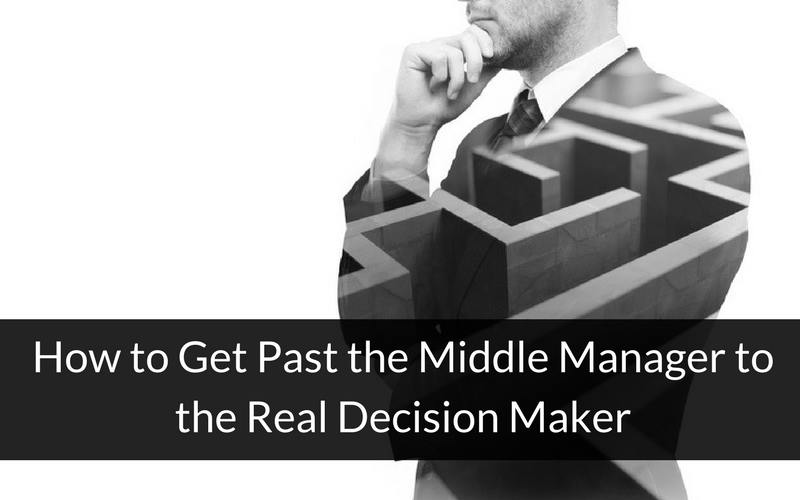
SCi Sales Group reports that it takes an average of 80 calls to get an opportunity to speak with a C-level executive. The group also found that 76% of junior executives rejected the last three sales calls they received; however, only 47% of higher executives did the same.
What does that tell us? The higher you reach, the more likely it is that you’ll actually connect to someone willing to take your call and able to make a decision. And that’s exactly what you want to do — begin your sales relationship with the most senior accessible contact.
Why Is This So Difficult?!?!
For starters, you need to determine the decision maker for your offer. Sometimes you may talk with a contact, and they may imply they’re the decision maker when they’re really just an influencer or researcher.
Influencers often feel they reside between a rock and a hard place. On one hand, they want to be perceived as a valuable contributor to the company’s success. On the other, they don’t want to end up with egg on their face for introducing the wrong salesperson and their respective solution.
Fear of failure and being blamed or rejected by senior management creates a cautious environment, making an influencer extremely reluctant to pass along any salesperson or solution, regardless of how good the offer sounds. If your sales representative is unable to show the business value to the middle manager, there’s no reason for that person to push things up the ladder.
What approach can your sales team take to calm the nerves of the influencer, give them the confidence to introduce you to the decision maker, and make them your champion?
Determine the Decision Maker Early
Before anyone from sales makes a call, they need to identify the probable decision maker and the information that would compel the buyer to agree to a conversation. Depending on the size of the company and the investment required, the decision maker is likely one of two positions, each with a slightly different agenda and interest.
- VP or Department Manager: Often referred to as the business buyer, this person is more interested in learning about productivity gains, process improvements, or cost reductions.
- C-Suite: C-Suite inhabitants are more interested in the financial aspect of your solution. Would it reduce costs, increase revenue, or improve profitability? What is the ROI?
Once you know who holds the purse-strings, you can plot a pathway to that individual or group. Begin with the most senior level person you can reach and work your way to the decision maker from there.
Use Caution in Your Approach
It’s in your best interests to balance your approach with influencers and researchers. If you come on too strongly, you can expect to encounter resistance or defensiveness. But if you play it right, you can make them your champion. Wait until you’re done with your initial conversation and then ask something like:
“Who else besides yourself is involved in this decision?”
You can also try to negotiate access to information for access to the decision maker. Pique the gatekeeper’s interest, but indicate you’ll present the additional desired information when the “other” decision makers are included in the conversation in order to make the best use of everyone’s time.
An alternative to asking for the decision maker is to speak the language of the decision maker rather than the middle manager. The influencer is likely a functional manager or even a user who speaks more about features and functions rather than ROI and Total Cost of Ownership. In this case, the influencer may feel less comfortable speaking about financial concepts and be happy to refer you upstairs.
In any case, be ready to help the researcher or influencer become your champion, able to explain the value of your solution to the senior decision makers. Share the business case you’ve started, and encourage the influencer to present it to the decision maker.
If you make your contact look good, you’ll have delivered value to the relationship, and ultimately the buyer will have the opportunity to see the overall value that you can deliver.
Steps to the C-Suite
You need to know who you want to talk to by name before you speak to anyone at your prospect’s company. As mentioned earlier, you want to talk to the most senior person who will benefit directly from the value you offer. Which door should you take to get there?
- Front Door: A direct contact-based sales approach highly tailored to each individual with a message that matches the needs and interests of the decision maker should capture the right attention.
- Side Door: Work your network. If you’ve established relationships inside the company, ask for their help in providing background on your identified decision maker. If you can secure an introduction, that’s even better. If you have no relationships, try community service or industry groups (whether in-person or virtual like those found on LinkedIn) to meet company insiders.
- Back Door: If there’s no way to reach the decision maker directly or otherwise network your way in, consider a potential vendor alliance with a company already engaged with the prospect. It could be the beginning of a beautiful partnership.
Value Selling Can Guide the Way
Value selling tools are flexible enough to focus on your buyer’s area of interest:
- Assessment tools and value calculators can be designed to provide specific data on your prospect’s business problem.
- Configure ROI and TCO tools to help sales capture and present the information decision makers want to know.
Put all the information together into a business case and become the consultant that helps your prospects increase revenue and reduce costs instead of the sales person selling just another product.















